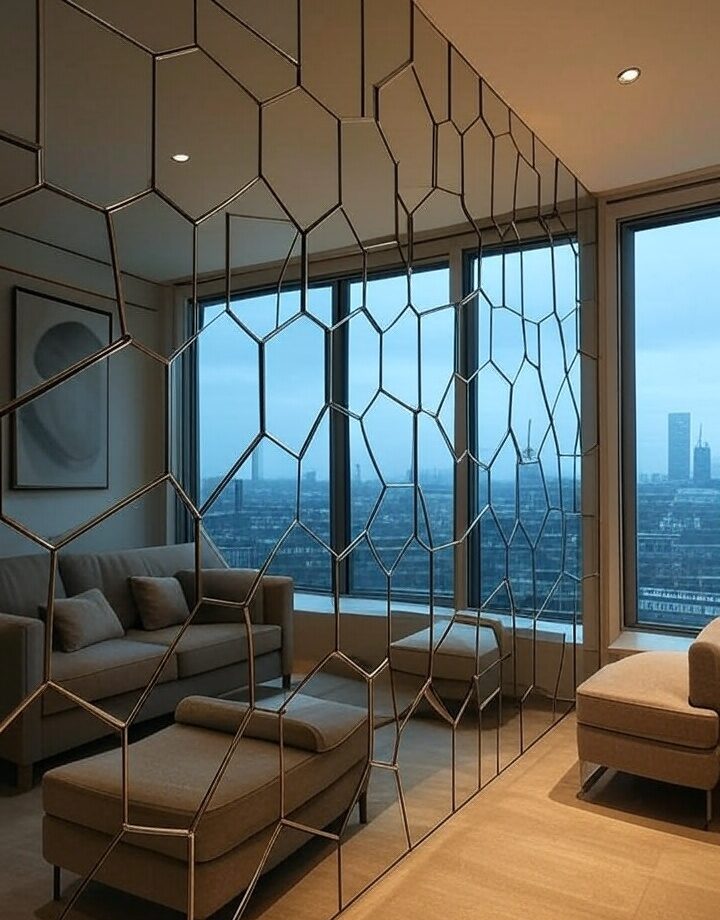
Mirror cladding is a sleek, reflective surface solution used in both residential and commercial interiors to create the illusion of space, increase light, and add a polished finish to walls, ceilings, columns, and furniture. But what exactly is mirror cladding, and how does it differ from mirror wall panels or traditional mirrored decor?
In this guide, we’ll cover:
- What mirror cladding is and how it works
- Common applications in interiors
- Benefits and considerations
- How it compares to mirror wall paneling
- Installation tips and maintenance
If you’re still deciding between cladding and other finishes, our blog on Mirror Wall Panels vs Mirror Cladding explores their differences in depth.
What Is Mirror Cladding?
Mirror cladding refers to the use of mirrored surfaces fixed onto various substrates like MDF, acrylic, glass, or aluminium composite panels (ACP), designed to cover walls, ceilings, pillars, doors, or cabinetry.
It’s typically applied using:
- Adhesives (for seamless finishes).
- Mechanical fixing systems (for flexibility in commercial fit-outs).
- Modular systems (e.g. aluminium-framed mirror panels).
Unlike standard mirrors, cladding is often designed for:
- Fire resistance
- Lightness (using acrylic or polycarbonate instead of glass.)
- Flexibility in application (curved surfaces, ceilings, etc.)
Where Can Mirror Cladding Be Used?
Mirror cladding is incredibly versatile. Common applications include:
Commercial Environments:
- Hotel receptions and lift lobbies
- Retail stores and changing rooms
- Restaurants and bars
- Office lobbies and boardrooms
Residential Interiors:
- Hallways to increase perceived space
- Feature walls in living or dining rooms
- Wardrobe doors or closet surrounds
- Ceiling panels in modern homes
For more design inspiration in residential settings, check out our Mirror Wall Paneling blog for use cases that blend elegance with functionality.
Benefits of Mirror Cladding
Here’s why mirror cladding is a go-to finish for modern interior design:
- Illusion of Space: Ideal for tight corridors or compact rooms.
- Enhanced Light: Reflects both natural and artificial lighting.
- Contemporary Aesthetic: Offers a clean, sleek look.
- Durability: Resistant to scratches and moisture (depending on material).
- Low Maintenance: Easily cleaned with non-abrasive glass cleaner.
Things to Consider Before Installing Mirror Cladding
While it adds instant visual appeal, there are practical considerations:
- Weight: Glass cladding can be heavy, acrylic alternatives may be preferred.
- Surface Prep: Walls must be level and free of defects.
- Safety: Toughened or laminated mirror cladding is recommended in high-traffic or public areas.
- Cost: Depending on material, installation method, and customisation.
Pro Tip: Acrylic mirror cladding is a lightweight alternative for ceilings or furniture cladding.
Mirror Cladding vs Mirror Wall Panels
While they appear similar, the installation method and design intent differ.
| Feature | Mirror Cladding | Mirror Wall Panels |
| Installation | Bonded or fixed to full surfaces | Framed, modular panels |
| Material Options | Glass, acrylic, ACP | Glass or mirrored MDF |
| Finish | Seamless, reflective skin | Framed or bordered modular look |
| Ideal For | Ceilings, curved or tight areas | Flat walls and features |
| Cost | Usually higher | Moderate to high |
If you’re considering both, read more in our Mirror Wall Panels vs. Mirror Cladding comparison.
Mirror Cladding Installation and Maintenance Tips
Installation:
- Ensure the surface is clean, level, and primed.
- Choose between adhesive or mechanical fixing based on wall type.
- Hire professionals for larger or ceiling applications to ensure safety and accuracy.
Maintenance:
- Use a soft cloth and mild cleaner.
- Avoid harsh abrasives or acidic solutions.
- Regularly inspect for chips or scratches – especially in high-contact areas.
Final Thoughts
Mirror cladding is more than just a decorative feature. It’s a smart, functional design choice for spaces that need light, depth, and a contemporary finish. Whether you’re updating a commercial lobby or enhancing a modern home interior, mirror cladding offers flexible, stylish solutions.
And if you’re unsure whether mirror cladding or wall panels suit your space better, we’ve covered both in detail across our mirror wall paneling blog and mirror cladding comparison page.
FAQs
Acrylic mirror cladding is lighter and shatter-resistant, making it safer and easier to install on ceilings or curved surfaces. Glass offers a clearer reflection and higher durability.
Yes, but ensure moisture-resistant backing and use sealed edges to prevent water ingress. Acrylic options are often preferred in humid spaces.
Absolutely. Lightweight acrylic mirror cladding is often used for ceilings to reflect light and add visual height to a room.
Yes, it amplifies both natural and artificial light, which helps brighten darker spaces without additional lighting.
It typically costs more than paint or wallpaper, but less than some stone or bespoke timber finishes. Cost varies based on material and installation.
Yes, as long as the surface is stable, smooth, and dry. Uneven surfaces should be corrected before installation.
Definitely. The reflective surface visually expands tight areas, making rooms feel larger.
With proper maintenance, mirror cladding can last over a decade without significant wear or fading.
Yes, most cladding materials can be custom-cut to fit your space. Always use appropriate cutting tools and safety gear.
No, it’s considered an interior finish and doesn’t typically need any planning approval unless part of a listed building.














